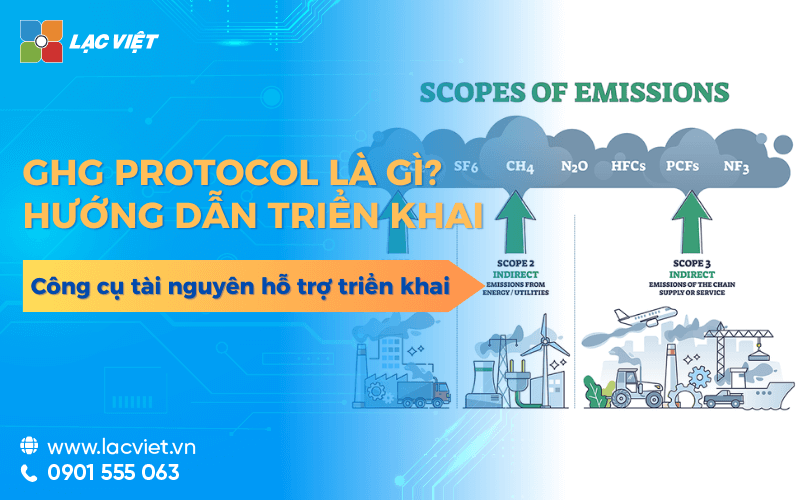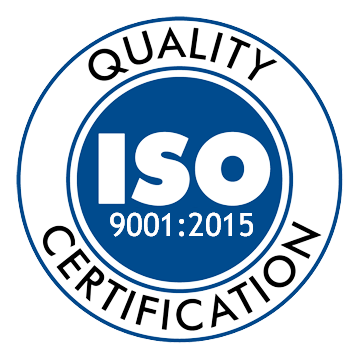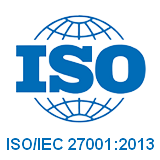In the context of the world are strong towards sustainable development, the business stands before requesting more clearly in the transparency of the greenhouse gases arising from the manufacture, operation and supply chain. To meet these requirements according to international standards recognized GHG Protocol is the starting point indispensable.
With the business Vietnam is in the process of building management system emissions, this article Lac will provide comprehensive information on the GHG Protocol – from concept, classification methods of emission, to how to implement practical as well as avoid the common mistakes.
1. GHG Protocol what is? Why businesses need to embrace this standard?
1.1 GHG Protocol what is?
GHG Protocol is abbreviation of “Greenhouse Gas Protocol” – a global guide to help businesses measure, manage and report greenhouse gas emissions in a manner consistent transparency. This is considered a basic foundation for any organization that wants to build control system, emission professional in accordance with the international standards of sustainable development.
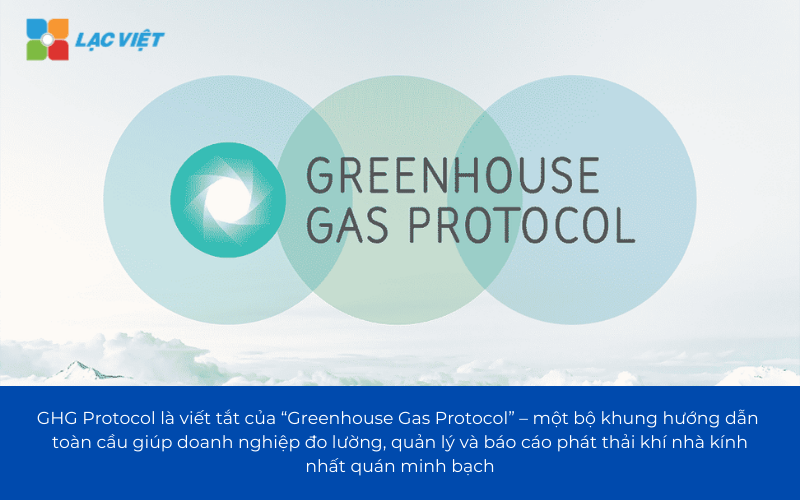
GHG Protocol is built by two prestigious institutions: World Resources Institute (WRI) and world Business Council for sustainable development world (WBCSD). This framework is not a standard legal imperative, but is more than 90% of enterprises belonging to the list of Fortune 500 applied, because it brings the standardized reliable in the reported emissions.
1.2 why GHG Protocol so important to business?
In the stage of the requirements for sustainable development, reduce emissions is becoming increasingly urgent, the measurement report emissions is no longer voluntary choice that has become the evaluation criteria important in many fields such as finance, supply chain, international bidding, especially in the program credits carbon. If businesses want to:
- Demonstrate the level of emissions transparency ago partners/investors,
- Market participants credits carbon metabolism efforts to reduce emissions into economic value
- Optimal operation and reduce energy costs and access to the financial incentives green
...then the applicable GHG Protocol is the initial step required.
GHG Protocol provides for business not only measurement tool but also a common language to communicate about emissions help business build credibility in the eyes of the market, well prepared for the demanding requirements in the future.
- Everything about iso 50001 standard in energy management for modern business
- CBAM is what? What should prepare to cope with adjustment mechanisms border carbon of the EU?
- CERS what is? Comprehensive certificates of emission reduction CERS for business
- Standard ESG is what? Complete guide to analysis and meet ESG effectively
2. GHG Protocol and the relationship with standard credits carbon
GHG Protocol holds the central role in the ecosystem of international standards related to emissions and credits carbon. If the business is considered credits carbon is the goal, the GHG Protocol is the primary data necessary evidence to prove that the amount of greenhouse gases has to be measured, reducing emissions actually occur.
Currently, the standard credits carbon international as Verra (VCS), Gold Standard, Climate Action Reserve... are required to report emissions based on the method of measurement in accordance with GHG Protocol. This means, if not, follow the GHG Protocol, business will be very difficult to be recognized legally, trade when you want to release credits carbon.
In addition, the GHG Protocol is also widely used in the report, ESG (environment, social, governance) report, sustainable development, and in the process, internal audits or reviews from side Tuesday. Thanks for using a common frame instructions, data emission of business will be comparing test higher to help the verification process faster – more reliable.
For example, A textile business in Vietnam want to participate in the market only voluntary carbon by investing system, solar on the roof studio. To prove this project actually help reduce emissions, businesses need to calculate the amount of greenhouse gas avoided by the method of GHG Protocol, then report submitted to the organization for verification. Thanks compliance processes, businesses can be recognized signal only carbon, from which seller credits, or used as evidence in the report ESG when working with international brands.
In summary, the GHG Protocol is not just a technical tool that is also a “global language” for businesses to communicate, demonstrate environmental responsibility in a reliable way. Understanding and applying the right GHG Protocol will help businesses not only to comply with the current requirements, but also create a position in the low carbon economy, are formed quickly around the world.
3. Three ranges of emissions in the GHG Protocol
One of those point to the core and is also easy to confuse most when businesses reach GHG Protocol is the concept of “three-scope emissions” (Scope 1, Scope 2, Scope 3). This is the GHG Protocol classification source of greenhouse gas emissions from the operation of an organization. Understanding each range to help businesses, more accurate measurement, the formulation of strategies to reduce emissions consistent than meets the full requirements when engaged in market credits carbon.
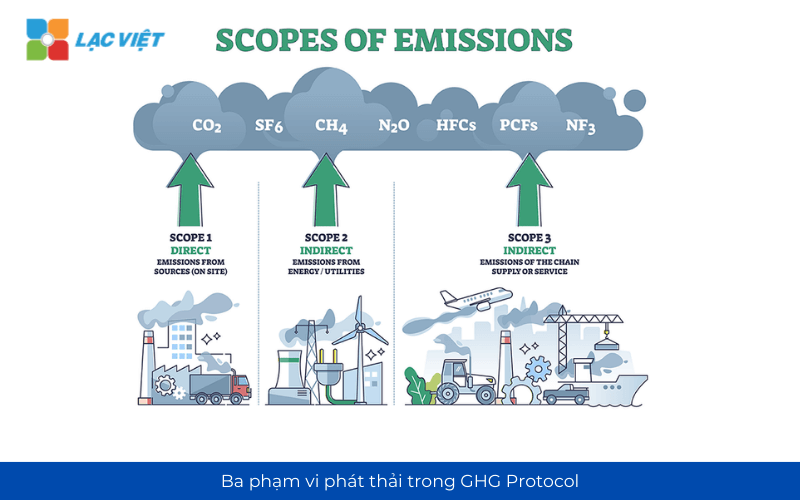
3.1. Scope 1 – direct emission or
Scope 1 is the type of emissions arising directly from the source that business ownership or control. Speaking in an understandable way, here is the amount of greenhouse gas is discharged by the operation of internal, that business can totally see measured.
Typical example:
- Factory use steam boiler, oil FO to generate steam for the production line
- Cargo truck owned by the business, using fuel or oil
- Refrigeration equipment in stock cause leakage of gas cooling
Practical value when measuring Scope 1: The control of emissions Scope 1 help businesses easily identify the points of emission right internally. This is also where the most action because businesses have full control equipment, process fuel use. Many businesses after measuring Scope 1 have discovered the area consume unnecessary energy and implementing changes to reduce operating costs significantly.
3.2. Scope 2 – emissions indirectly from energy consumption
Scope 2 refers to the amount of greenhouse gases arising indirectly from the business use of electricity, heat, steam or power purchased from outside. Although businesses do not directly burn fuel to create this type of energy, but it is the end users – so still need to calculate emissions related.
Specific example:
- Business office use electricity from the national grid → emissions CO₂ indirectly from the process of production of electricity
- Factory use steam to buy from a nearby factory to heat for the production process
Why Scope 2 important?
In Vietnam, the grid is still mainly produced from coal and natural gas, so that emissions indirectly from electricity consumption accounted for the significant in the total emissions of many businesses. Tracking Scope 2 help businesses identify potential transition to clean energy, at the same time serve as a basis to demonstrate the improvement when investing in solar or optimize the use of electricity.
3.3. Scope 3 – emissions indirectly in the entire value chain
Scope 3 is the range of emission wide most complex includes all the emission is not in Scope 1 and Scope 2 but arise from activities related to the business throughout the product life cycle and supply chain.
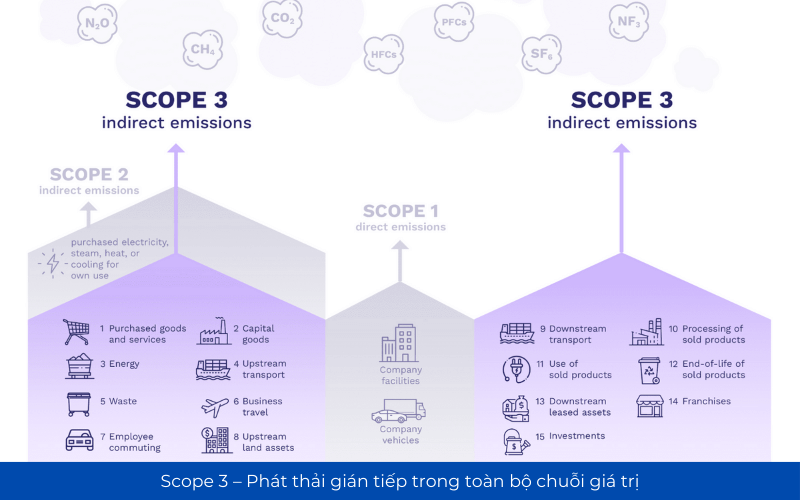
Example of Scope 3:
- Emissions from transportation of raw materials from suppliers to the factory
- Journey work of the staff by plane or car
- Emissions from the customer using the product (e.g., an electronic product power consumption during use)
- Waste after production
Although Scope 3 very spacious difficult to control than because it is located outside the boundary operator directly, but often up to 60-80% of the total emissions of the business. Large organizations are shifting focus on Scope 3 because this is the area the potential to create value difference, especially when coordinate with suppliers or partners operate to improve the general performance of the supply chain.
Benefits when measuring Scope 3:
- Create advantage when bidding with international partners required to report ESG full
- Mounting environmental strategy with the parts in and out of business (purchasing, logistics, sales)
- Orientation initiatives, sustainable, more comprehensive help enhance brand image
The classification of emissions by scope Scope 1, 2, 3 help businesses not only understand more about the “carbon footprint” of yourself, but also know which should begin to act from now to achieve fast performance the most obvious. The new business development should focus on Scope 1 and 2 to build the foundation, then open wide to Scope 3 when there was enough capacity or have a support system.
GHG Protocol does not require the business to do all immediately that encourages step by step for improvement, as long as there is clear roadmap with data fidelity. Here is how to business English step by step asymptotic international standards, market participants credits carbon enhance competitiveness and sustainable.
4. Practical benefits when businesses apply GHG Protocol
Below is the actual value that the business can get when properly implemented GHG Protocol:
- Enhance the transparency and credibility in reporting on sustainable development
GHG Protocol provides a standard framework to help businesses build the emissions reporting reliable. This is especially important in the context of the partners, investors and regulators increasingly require companies to disclose environmental data clearly. A report emissions built-basically according to the GHG Protocol not only help business responsibility, but also strengthened from the outside.
- Create a platform to market participants credits carbon
To be recognized transaction credits carbon data, the emission of the business to be measured exactly transparent. GHG Protocol is one of the accepted methods popular by the standard credit international as Verra or Gold Standard. When there is measurement system according to the GHG Protocol, the business can demonstrate the effectiveness of the projects to reduce emissions (e.g., transition to renewable energy), thereby creating source credits carbon can sell or use to offset emissions internally.
- Reduce operating costs through optimized energy consumption
One of the benefits is easily seen when measuring emissions that the business can determine the area of energy consumption is not effective. Through the analysis of data emissions according to each type of activity, each workshop or processes, businesses can make decisions improved operation in order to save energy costs, reduce waste, improve production performance.
- Expand opportunities for access to capital green, the fund supports international
Financial institutions such as World Bank, ADB, JICA or the fund ESG are now giving priority to support the business strategy emission transparent clear. When the business prove that they are managing emissions according to the GHG Protocol, which is a huge plus to access concessional loans, grants or other credit schemes blue.
- Increase the ability of the winning bid and maintain its position in the global supply chain
Many multinational corporations requires suppliers to provide data emissions periodically as a mandatory condition to maintain cooperation. Applying GHG Protocol to help businesses meet this requirement in an active way, from that increase the likelihood of winning bid hold firmly in position in the supply chain and expand international cooperation.
Evidence typical: as reported By McKinsey in the year 2023, the business system, measurement management, emission, transparency according to the GHG Protocol has the ability to increase 14% of brand value in the eyes of investors, at the same time be evaluated higher in the rankings, reputation for ESG.
5. The step by step build system, measure emissions according to the GHG Protocol
To successfully implement the GHG Protocol, businesses do not necessarily have the system complex technology right from the start. Is important to have clear roadmap and methods, consistent with reliable data. Here are 6 steps core can be applied flexibly according to the scale, characteristics, industry of each unit.
Step 1: Determine the target range for emissions reporting
Before embarking on measurement, enterprises need to clarify the purpose of the construction of the emission system. Can is to serve internal report, published ESG profiles credits carbon, or to improve the production process. When determining the target business will be easy to choose the scope of the organization, boundaries, activities need to measure.
Illustrative example: A manufacturing company wants to control emissions in the entire value chain can be measured for the entire plant and all logistics operations related. But if the new start, the business can only measure at a workshop to test pattern.
Step 2: collect input data
Data is the foundation of the entire system. Business needs to collect the information related to the consumption of energy, raw materials can greenhouse gas emissions. The data source common include:
- Electricity bills, water, fuel (gas, oil, coal, gas...)
- Number of km of movement of vehicles owned company
- The amount of material consumption in production
- Data from the system production management, accounting, internal
Note: Data should be stored systematic, clear about the time, the source of the. This allows the calculation of the check later became convenient, save time cost.
Step 3: Apply the method of calculation according to the GHG Protocol
After obtaining the data, enterprises need to convert the consumption figures of the amount of greenhouse gas emissions, which is often measured in units of “tonnes of CO₂ equivalent”. GHG Protocol provides the method of calculation and number system conversion suitable for each type of activity.
For example: If the plant consumes 10,000 kWh of electricity per month, the business will be multiplied by the emission of grid (for example: 0,913 kg CO₂/kWh in Vietnam according to the coefficient of MONRE 2022) to the emissions respectively.
Practical value: This is the business easily see where emissions the most to prioritize improvements. The simple analysis will initially open towards cost savings, improved operational efficiency.
Step 4: Classification of emissions under Scope 1, 2, 3
Here are steps to help business group emission sources in the correct range according to international standards, including:
- Scope 1: emissions directly from the operation of business control (burning fuel, gas, cooling...)
- Scope 2: emissions indirectly from energy purchased from outside (such as electricity, steam...)
- Scope 3: emissions throughout the value chain (transport, trip, customer behavior...)
Hint deployment: Business should start with Scope 1 and 2 ago because it is easy to collect control. Scope 3 should implement the following when there have been data platform firmly.
Step 5: inspection, verification, internal or cooperate with unit Tuesday
After obtaining the data, calculation results, businesses need to check the accuracy, consistency and transparency of reporting. The verification can be done internally in the first stage or thanks to specialized units outside if you need the report or release credits carbon.
Note: The verification is not only to “check in right and wrong”, but also help enterprises recognize the flaw in the process, collect data, improve the system in the long term.
Step 6: reporting on periodic updates
After completing the steps above, businesses need to report emissions greenhouse by year (or cycle in accordance with the plan internal environment or requirements of partners). The report needs to articulate the range of emission calculation methods, data sources, as well as changes in comparison with the previous period (if any).
Why periodic reports important? Since the report reflects not only results, but also demonstrates the ongoing commitment of the business in reducing emissions, risk management environment. This document is important when businesses participate in the program credit only carbon, capital mobilization, blue, or signing in cooperation with the partner that requires the ESG.
6. Resource tool to support business development GHG Protocol
The deployment of GHG Protocol, in fact, is not a too complicated process if the business is equipped with the right tools, the appropriate guidance. Here are the resources essential to help businesses easily start measuring emission standard international:
- Form to calculate GHG according to each type of business
International organizations and units of consulting expertise has now evolved multiple forms (template) calculate the amount of emissions is suitable for the different industries such as manufacturing, construction, trade, service. These generally include the input method switching unit consumption (as the fuel) into the amount of gas CO₂ equivalent, instructions fill in the data.
- Number system conversion emission (Emission Factors) updates from reputable sources
Enterprises need to use the coefficient of emission latest – for example, from the IPCC (the intergovernmental panel on climate change) or DEFRA (Department of Environment, Uk) – to convert the energy consumption of emissions. The exact number will help the measurement result has a value, recognized when reported outside.
- Software to manage greenhouse gas emissions
There are many software from free to commercial support, data management, emissions standards GHG Protocol. Depending on the scale peculiarities industry, businesses can choose from the solution Excel has the recipe available to the system, integrated software has the ability to store data, create reports, automatically support the audit.
- List the consultant to verify emissions credits
If the business is not have enough capacity internal, the cooperation with the units-depth consultation about measurement of emissions is the right option. These units can support the construction of the system, training of personnel, calculation of test data, at the same time guide the verification process side Tuesday if the business needs release credits carbon.
- Training material internal implementation guide step by step
For the system to operate sustainable businesses that need to build capacity intrinsic. The organization of the internal training, provide documentation according to understandable language in accordance with the context that Vietnam will help the hr team approach faster with the concept of GHG, understand the steps taken to operate the system in an active way.
7. Mistakes businesses often encounter when applying GHG Protocol
Applying GHG Protocol in the management emissions not only requires compliance process, but also need to understand the true nature and flexibility in accordance with the practice business. In fact, no less troubled institutions or fall into error when deployed, causing the system becomes lack of trust, even losing the chance to participate in the program credit carbon or report ESG seriously.
Below are the common mistakes that businesses need special attention to avoid risk, wasted resources:
- Just focus on Scope 1 that ignores the Scope 2 and Scope 3: business as new approaches to GHG Protocol often only focus on Scope 1 – i.e. emissions from internal operations such as burning fuel, operate the device. However, Scope 2 (emissions from electricity consumption), especially Scope 3 (emissions in the entire value chain) back often occupy large part of the total emissions.
- Does not store measurement data clear, transparent: A serious mistake other is the lack of storage systems organize data. When input data is not collected in full, without notes remove the source or there is no mechanism to cross-check, then the calculation of emissions will lack reliability, tough when needed verification from the Tuesday.
- Typical situation: Business collect electricity bills of the workshop but not specific notes cost to the production range, the cost for regional offices that report emissions does not reflect the true fact is easily dismissed as verification.
- Copy the report template that does not reflect the actual emission of business: Because of time pressure or lack of resources, some businesses tend to re-use report templates from other units, only change the basic information that is not based on actual data of his unit. This potential risk, affects not only the accuracy but also lose credibility if it was discovered during audits or reviews from partners.
- No system updates of new emission by time: the emission – i.e., the conversion rate from energy consumption (such as electricity, fuel) to the emission of CO₂ equivalent – not fixed parameters. They are usually updated every year by organizations such as the IPCC, the Ministry of natural resources and Environment or the specialized agencies in each country.
- Errors frequently: Business use of old from several years ago, leading to results measurement deviations, does not properly reflect the current context. This can do wrong plan to reduce emissions and record credits carbon, which causes loss of credibility with stakeholders.
Compliance GHG Protocol requires not only technically but also the long term commitment of business in sustainable development and international integration. It is important that businesses do not need to start with large-scale or complex technology. Just approach the GHG Protocol properly, starting from the basic step with real data have clear roadmap, then even the small and medium enterprises can also built a measurement system reliably delivers real value.

